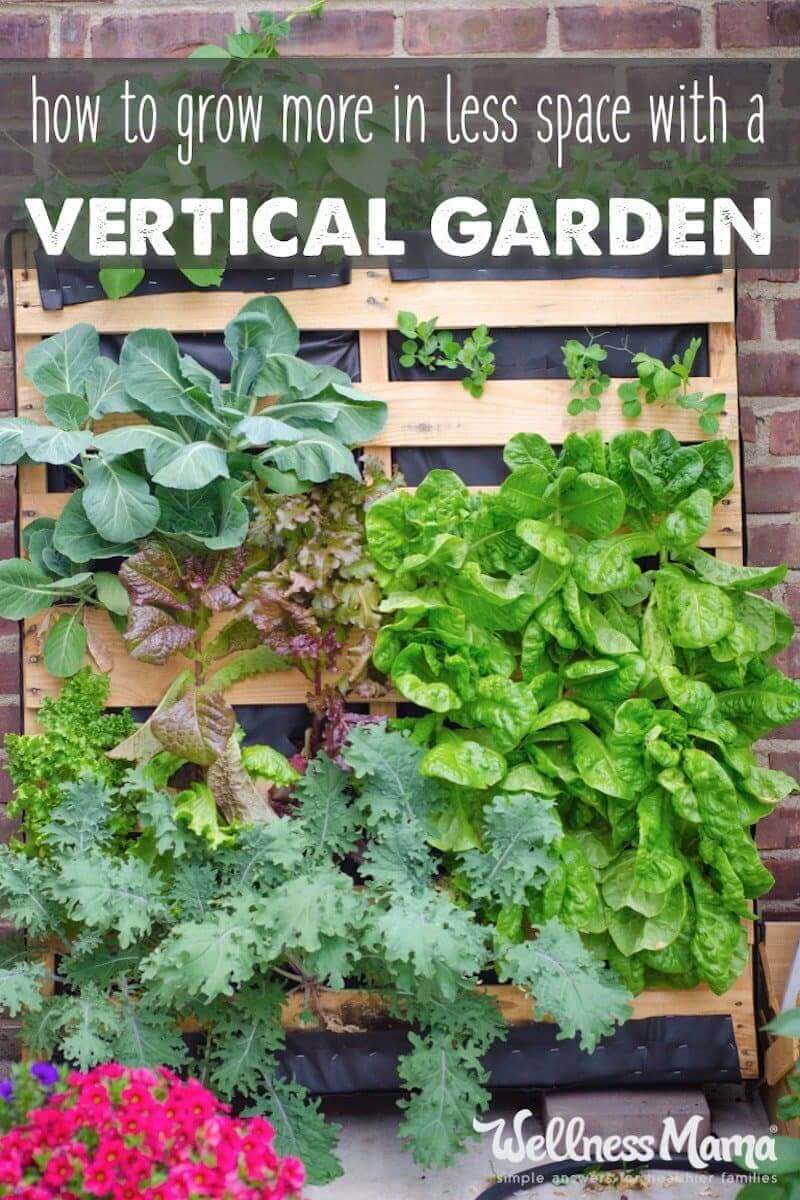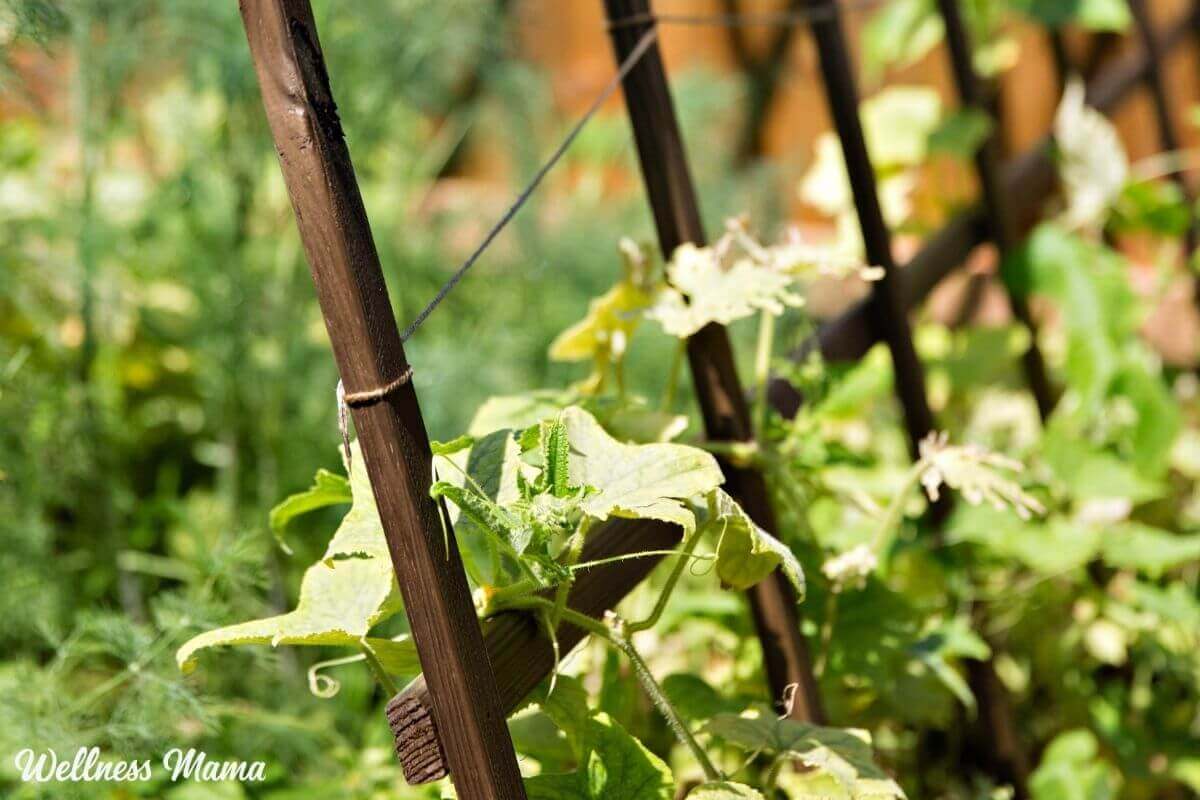Interior decorators know the classic design tip: when working with a small space, look up!
Using empty wall space in creative ways can make all the difference in an apartment or small home (I learned this firsthand), and it can work in a garden too! If your outdoor space is limited, these vertical gardening ideas can take your garden to the next level!
What Is a Vertical Garden?
Put very simply, a vertical garden is a way to encourage fruits, vegetables, herbs or flowers to grow up instead of down on the ground, by means of some kind of support or structure. It can be done in the ground, in containers, on a wall, or even without soil.
The best edible plants for growing in a vertical garden have climbing or vining habits, like cucumbers, tomatoes, pole beans, peas, and even a variety of squash and pumpkins. (You can also add vining flowers to your vertical elements for beauty, too!)
While lack of space (such as in an urban or apartment setting) usually motivates the vertical approach, there are many other advantages to this creative way of gardening:
- Disease prevention
- Ease of harvest (no bending over)
- Higher yield
- More shapely produce (no flat side from laying on the ground)
- Visual interest or even privacy
- Portability; some container systems can be moved to follow available sun
- Controlling invasive or wide-spreading plants like squash vines
- Creates shelter for shade-loving plants (or people)
The possible ways a vertical garden might look are endless, from the very simple and cheap to the breathtakingly complex and expensive. With an indoor growing light and the right system, you could even grow year-round produce in your house!
But this begs the question:
To DIY or Not to DIY?
I first became interested in vertical gardening (beyond just staking beans or caging tomatoes) when a friend purchased a Tower Garden system. They are pricey, but the idea of growing lettuce, kale, cucumbers, beans, and even tomatoes in a few square feet on a patio or even year-round indoors? Tempting. (And for someone in an urban setting and with the rising cost of organic produce, possibly worth it!)
(Update: I since found a smaller, less expensive indoor garden option from AeroGarden. Full details in a later post, but I have the Harvest Family model. It was easy to put together and the kids are loving watching it grow!)
Of course, I immediately began to think of ways I could make my own, more economical DIY vertical gardening system, and there are many DIY tutorials out there. If it’s a soilless system you’re after, the list of materials can be long and still around $200-250.
For now, I decided to go a simpler route and see what I could do to adapt our traditional outdoor garden beds and make them more efficient, and maybe add a small indoor herb and lettuce garden for the winter.
Before you decide whether to buy or DIY, do some sleuthing around the basement or garden shed. You’ll be surprised what inspiration you can find. Just look for anything a plant could grow in and up. Pallets, mason jars, old shutters, a broken ladder, construction rebar, a piece of trellis, twine, rope–these can all be made into a vertical garden structure.
So while the jury’s still out as to which approach we’ll eventually try, here are 5 intriguing vertical garden ideas ranging from simple to sophisticated!
Traditional Garden With Vertical Elements
If you have an existing backyard garden, plan to add a trellis and climbing plants on the north side of your plot. This keeps your taller plants from shading the rest of the garden. I also suggest using a support that is portable and not permanent, so you can rotate your plantings from season to season.
Here are some ideas for how to grow your plants vertically in a traditional garden bed:
- Cucumbers – try this easy tent trellis or hoop trellis
- Corn, Pole Beans, and Squash – try a Three Sisters Garden
- Squash (Acorn, Butternut, Delicata) – train the vines up the four legs of a ladder or hoop trellis (huge space saver!)
- Tomatoes – use sturdy vertical cages or (if you’re handy) an A-frame trellis
Don’t forget to plant lettuce, spinach, and other delicate, shade-loving plants in the shade these trellises provide!
Patio Planter/Container Garden
If you’re confined to a patio or deck, try gardening tomatoes, lettuce, cucumbers, beans, or squash in containers. You can create your own garden with individual pots, tiered planters, or a raised garden box. (Although they look beautiful, keep in mind that real terra cotta pots are very porous and prone to drying out.)
Use organic potting soil and consider putting heavier pots on dollies so you can maximize sun exposure–the real key to container gardening. Tie plants to tomato cages and support stakes as they grow up for unlimited space.
Outdoor or Indoor Wall Garden
If you are short on horizontal space but have a wall or fence that gets 6 or more hours of sunlight, try a wall garden. These can even be indoors if you have a very sunny exposure or grow light. A wall garden can be constructed out of wood scraps, small pots, or even canvas pockets (like an old over the door shoe organizer). I love this beautiful DIY version made from cedar wood.
As with all container gardens, it can be tricky to keep a wall garden evenly watered and fertilized (yet not overwatered out of paranoia!).
If you are going to try the garden indoors, consider a system made for this purpose. Unless you plan to mount a grow light, I recommend using something with removable containers for the individual plants so you can move them closer to a window if needed.
Indoor Herb Garden
Windowsill herb gardens are nothing new, but deserve an honorable mention because what is better than fresh lettuce or herbs in the winter? In a warmer climate, a few mason jars on the kitchen windowsill or hanging in pots will do the trick, but in colder climates a grow light kit will almost certainly be necessary.
And I love these ideas on how to use IKEA items for an indoor garden!
Hydroponic Garden
Another type of vertical gardening, hydroponics, has enjoyed a surge of popularity in recent decades. Hydroponic vegetables are grown only in water (no soil) with nutrients and trace minerals added. While this method dates back to the ancient Aztecs, the modern hydroponic method involves a lot of plastic and some synthetic fertilizers, and I’ve held back from exploring it for these reasons. (It can also be expensive, as I mentioned above.)
On the other hand, vegetables grown hydroponically in a greenhouse do not require chemical pesticides. Studies are limited, have even been found to be nutritionally superior (although some would say, not in taste).
If home hydroponics sounds like an experiment you’d like to try, you can make your own if you’re adventurous or check out cheaper alternatives to the Tower Garden system.
What do you think of vertical gardening? Have you had success with these or other methods?



Leave a Reply